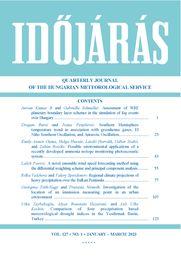IDŐJÁRÁS - angol nyelvű folyóirat
Vol. 127, No. 1 * Pages 1–142 * January - March 2023
 |
|
 letöltés [pdf: 5762 KB]
letöltés [pdf: 5762 KB]
Assessment of WRF planetary boundary layer schemes in the simulation of fog events over Hungary
Jeevan Kumar B and Gabriella Schmeller
DOI:10.28974/idojaras.2023.1.1 (pp. 1–22)
Jeevan Kumar B and Gabriella Schmeller
DOI:10.28974/idojaras.2023.1.1 (pp. 1–22)
IDŐJÁRÁS folyóirat

Az IDŐJÁRÁS a HungaroMet Nonprofit Zrt. negyedévenként megjelenő angol nyelvű folyóirata
Megrendelhető a journal.idojaras@met.hu címen.
A szerzőknek szánt útmutató itt olvasható.
Megrendelhető a journal.idojaras@met.hu címen.
A szerzőknek szánt útmutató itt olvasható.









